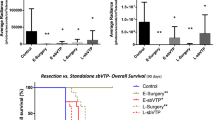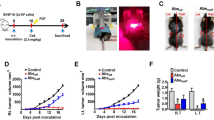Abstract
In photodynamic therapy (PDT), photosensitisers accumulate somewhat preferentially in malignant tissues; photoactivation with appropriate wavelength of light release toxic molecular species which lead to tumour tissue death. In order to target ovarian cancer with increased specificity, a chlorin-based photosensitiser (chlorin e6 monoethylendiamine monoamide) was conjugated to OC125, a monoclonal antibody recognising an antigen expressed in 80% of non-mucinous ovarian cancers. In previous work, this immunoconjugate (IC) was shown to be selectively phototoxic to cancer cells from ovarian cancer patients ex vivo and to localise preferentially in ovarian cancer tissue in vivo. In this study we report results from in vivo phototoxicology and photodynamic treatment studies using this IC in a murine model for ovarian cancer. A comparison of single vs multiple treatments was also made. For in vivo experimentation, Balb C nude mice were injected with 30 x 10(6) NIH:OVCAR 3 cancer cells to create an ascitic tumour model. Animals were then given intraperitoneal injections of the immunoconjugate (0.5 mg kg-1). Twenty-four hours later the intraperitoneal surfaces were exposed to 656 nm light from an argon-ion pumped-dye laser (50 mW, 656 nm), using a cylindrical diffusing tip fibre. The overall treatment was given either once or multiply. No animals died from treatment complications. Twenty-four hours following one and three PDT treatments, the percentage of viable tumour cells in the ascites of the treated animals analysed ex vivo was 34% and 5% of control for one and three treatments respectively. With respect to survival, all control mice (n = 18) died between 30 and 50 days. However, for those treated three times (n = 10), 40% were still alive after 50 days, and for those treated four times (n = 12) 58% were alive after 50 days. Evaluation with log-rank test revealed a significant survival with intraperitoneal PDT compared with controls (P = 0.0006). These preliminary results suggest that PDT with an OC125 immunoconjugate may be an effective therapy for the management of advanced ovarian cancer. Clinical application of this therapy needs to be further optimised and may require multiple treatments, similar to fractionated radiation therapy and cyclic chemotherapy, in order to control malignant disease with acceptable toxicity to normal tissue.
This is a preview of subscription content, access via your institution
Access options
Subscribe to this journal
Receive 24 print issues and online access
$259.00 per year
only $10.79 per issue
Buy this article
- Purchase on Springer Link
- Instant access to full article PDF
Prices may be subject to local taxes which are calculated during checkout
Similar content being viewed by others
Author information
Authors and Affiliations
Rights and permissions
About this article
Cite this article
Goff, B., Blake, J., Bamberg, M. et al. Treatment of ovarian cancer with photodynamic therapy and immunoconjugates in a murine ovarian cancer model. Br J Cancer 74, 1194–1198 (1996). https://doi.org/10.1038/bjc.1996.516
Issue Date:
DOI: https://doi.org/10.1038/bjc.1996.516
This article is cited by
-
Effects of combination of melatonin and laser irradiation on ovarian cancer cells and endothelial lineage viability
Lasers in Medical Science (2016)
-
Polymeric nanocarrier systems for photodynamic therapy
Biomaterials Research (2014)
-
Minimally-invasive debulking of ovarian cancer in the rat pelvis by means of photodynamic therapy using the pegylated photosensitizer PEG-m-THPC
British Journal of Cancer (1999)
-
BPD-MA-mediated photosensitization in vitro and in vivo: cellular adhesion and β1 integrin expression in ovarian cancer cells
British Journal of Cancer (1999)



